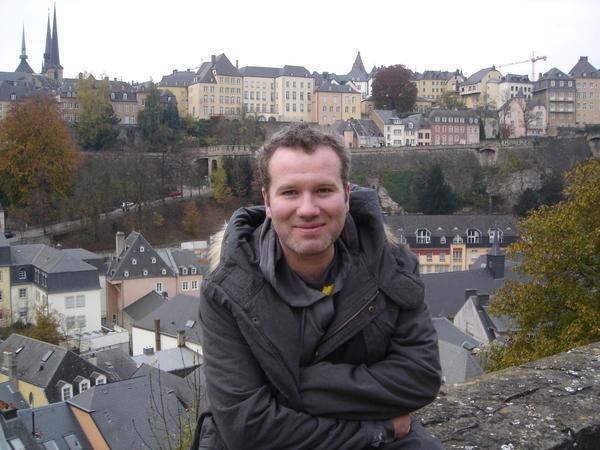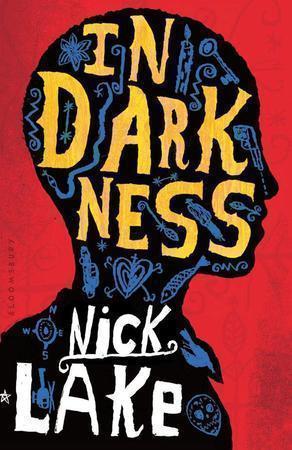 Author Nick Lake is fascinated with every aspect of books — the type, the printing, the binding.
Author Nick Lake is fascinated with every aspect of books — the type, the printing, the binding.
Nick grew up in a home full of books, and his mom (or mum as he calls her) taught him to read before he went to school. It meant he was always reading. “I think from quite early on, I wanted to make (a book) myself,” Nick told Cracking the Cover. “Certainly from being a teenager, though I had a brief dalliance with poetry, which I bitterly regret.”
Now an adult and a published author, Nick’s fascination with books has only grown. He even has one of the thin metal plates that were used to print his book “In Darkness.” “There are 32 pages on it, some upside down, and when it’s used for printing, the big sheet that it makes is folded up to make one of the signatures in the book. Those are the quill-like shapes you see if you look at a book from the top — the sections it’s printed in,” Nick digressed.
“My point is,” he continued, “I love books entirely — the stories in them, but also their physical form, everything that goes into making them, from the fonts to the copyediting. Being a publisher and a writer means getting to indulge that love completely.”
Nick isn’t sure how he ended up writing for young readers, though he says it probably had something to do with when he went into publishing in the early 2000s. Children’s books were going through a golden age during that time, and books like “Coraline” and “How I Live Now Myself” seemed to be “redefining what it was possible to achieve in a relatively short novel.”
He became a children’s and YA editor. Doing that for several years, Nick says, was almost like a creative writing course. “By giving comments on other people’s stories, you learn a huge amount about writing,” Nick said. “So it never occurred to me to write anything else. I wouldn’t have the first idea how to write a book for adults, though in the U.K. ‘In Darkness’ is being published as an adult book too, which is kind of a thrill.”
 “There’s something else, too,” Nick added. “I feel that a lot of adult literature, leaving aside genre fiction, has (with some exceptions) become more and more focused on a kind of philosophical exploration of what it means to be a person, rather than on storytelling. There’s nothing at all wrong with that, but personally, I spent enough time on philosophy at university — I don’t want to read, or write, about someone having an existential crisis. Pedro Juan Gutierrez, a Cuban writer, says that the only proper subjects for books are death and love, the darker side of being human. I kind of agree with that, and I think it’s easier to do it when your characters are young.”
“There’s something else, too,” Nick added. “I feel that a lot of adult literature, leaving aside genre fiction, has (with some exceptions) become more and more focused on a kind of philosophical exploration of what it means to be a person, rather than on storytelling. There’s nothing at all wrong with that, but personally, I spent enough time on philosophy at university — I don’t want to read, or write, about someone having an existential crisis. Pedro Juan Gutierrez, a Cuban writer, says that the only proper subjects for books are death and love, the darker side of being human. I kind of agree with that, and I think it’s easier to do it when your characters are young.”
“In Darkness” takes place in the aftermath of a devastating earthquake in Haiti. It follows “Shorty,” a Haitian boy trapped in the ruins of a hospital. As Shorty waits in darkness to be rescued, he becomes aware of another presence, one reaching out to him from 200 years in the past. It is the presence of slave and revolutionary leader, whose own end came in darkness.
The 2010 Haitian earthquake sparked Nick’s first idea for “In Darkness.” Watching news footage of people being dug out from the rubble days afterward the quake “got me thinking about what it must be like to go through such an awful experience, but also about hope and darkness and the troubles Haiti had even before the earthquake…”
Once the idea popped into Nick’s head, he didn’t write it. He says it just flowed out. “I often didn’t know what I’d written when I finished each train journey and closed my laptop. That isn’t meant to be pretentious, or to disclaim responsibility for the book: it’s simply true. The story was just there, and I wrote it down.”
“I’m not making it up when I say that I wasn’t really conscious of writing it,” Nick said of the driving intensity throughout his book. “That said, as an editor and a reader, I’m less and less tolerant as time goes by of florid writing, so I guess I was aware on some abstract level of wanting it to be tight and declarative, and for it to — for want of a better expression — be full of stuff happening, all the time. I don’t want passages of description, or long sections of dialogue — I want it to be brutal, and simple, so that the writing kind of shimmers with violence, too. Not that it’s something I set out to do, I stress again. But if I had to say what I hope it’s like, that’s what I’d say.”
“There’s a line on the back of the book, ‘Sometimes, on the other side of darkness, there is light,’ Nick said. “I think that for me sums up what the book is about. Awful, awful things happen in it, but there’s hope, too.”
**Nick spent a lot of time and care answering Cracking the Cover’s questions. Read the complete transcript of his interview and learn more about how he blended the lives of his two main characters together across time, how his life experiences came into play, his favorite book from childhood and what he’s working on now.
